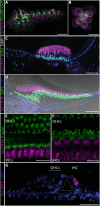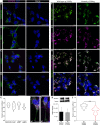Mutation of SLC7A14 causes auditory neuropathy and retinitis pigmentosa mediated by lysosomal dysfunction
- PMID: 35394837
- PMCID: PMC8993119
- DOI: 10.1126/sciadv.abk0942
Mutation of SLC7A14 causes auditory neuropathy and retinitis pigmentosa mediated by lysosomal dysfunction
Abstract
Lysosomes contribute to cellular homeostasis via processes including macromolecule degradation, nutrient sensing, and autophagy. Defective proteins related to lysosomal macromolecule catabolism are known to cause a range of lysosomal storage diseases; however, it is unclear whether mutations in proteins involved in homeostatic nutrient sensing mechanisms cause syndromic sensory disease. Here, we show that SLC7A14, a transporter protein mediating lysosomal uptake of cationic amino acids, is evolutionarily conserved in vertebrate mechanosensory hair cells and highly expressed in lysosomes of mammalian cochlear inner hair cells (IHCs) and retinal photoreceptors. Autosomal recessive mutation of SLC7A14 caused loss of IHCs and photoreceptors, leading to presynaptic auditory neuropathy and retinitis pigmentosa in mice and humans. Loss-of-function mutation altered protein trafficking and increased basal autophagy, leading to progressive cell degeneration. This study implicates autophagy-lysosomal dysfunction in syndromic hearing and vision loss in mice and humans.
Figures








Similar articles
-
SLC7A14 linked to autosomal recessive retinitis pigmentosa.Nat Commun. 2014 Mar 27;5:3517. doi: 10.1038/ncomms4517. Nat Commun. 2014. PMID: 24670872 Free PMC article.
-
Phenotypic variability of SLC7A14 mutations in patients with inherited retinal dystrophy.Ophthalmic Genet. 2019 Apr;40(2):118-123. doi: 10.1080/13816810.2019.1586964. Epub 2019 Mar 29. Ophthalmic Genet. 2019. PMID: 30924391
-
Screening for SLC7A14 gene mutations in patients with autosomal recessive or sporadic retinitis pigmentosa.Ophthalmic Genet. 2017 Jan-Feb;38(1):70-73. doi: 10.3109/13816810.2015.1136336. Epub 2016 Mar 30. Ophthalmic Genet. 2017. PMID: 27028480
-
Autosomal dominant retinitis pigmentosa with toxic gain of function: Mechanisms and therapeutics.Eur J Ophthalmol. 2021 Mar;31(2):304-320. doi: 10.1177/1120672120957605. Epub 2020 Sep 22. Eur J Ophthalmol. 2021. PMID: 32962414 Review.
-
Disease mechanisms of X-linked retinitis pigmentosa due to RP2 and RPGR mutations.Biochem Soc Trans. 2016 Oct 15;44(5):1235-1244. doi: 10.1042/BST20160148. Biochem Soc Trans. 2016. PMID: 27911705 Review.
Cited by
-
Molecular and cytological profiling of biological aging of mouse cochlear inner and outer hair cells.Cell Rep. 2022 Apr 12;39(2):110665. doi: 10.1016/j.celrep.2022.110665. Cell Rep. 2022. PMID: 35417713 Free PMC article.
-
Molecular specializations underlying phenotypic differences in inner ear hair cells of zebrafish and mice.Front Neurol. 2024 Oct 17;15:1437558. doi: 10.3389/fneur.2024.1437558. eCollection 2024. Front Neurol. 2024. PMID: 39484049 Free PMC article.
-
Hypothalamic SLC7A14 accounts for aging-reduced lipolysis in white adipose tissue of male mice.Nat Commun. 2024 Sep 11;15(1):7948. doi: 10.1038/s41467-024-52059-1. Nat Commun. 2024. PMID: 39261456 Free PMC article.
-
Unexpected Motherhood-Triggered Hearing Loss in the Two-Pore Channel (TPC) Mutant Mouse.Biomedicines. 2022 Jul 15;10(7):1708. doi: 10.3390/biomedicines10071708. Biomedicines. 2022. PMID: 35885013 Free PMC article.
-
Lysosomes in retinal health and disease.Trends Neurosci. 2023 Dec;46(12):1067-1082. doi: 10.1016/j.tins.2023.09.006. Epub 2023 Oct 16. Trends Neurosci. 2023. PMID: 37848361 Free PMC article. Review.
References
MeSH terms
Substances
Supplementary concepts
Grants and funding
LinkOut - more resources
Full Text Sources
Molecular Biology Databases

